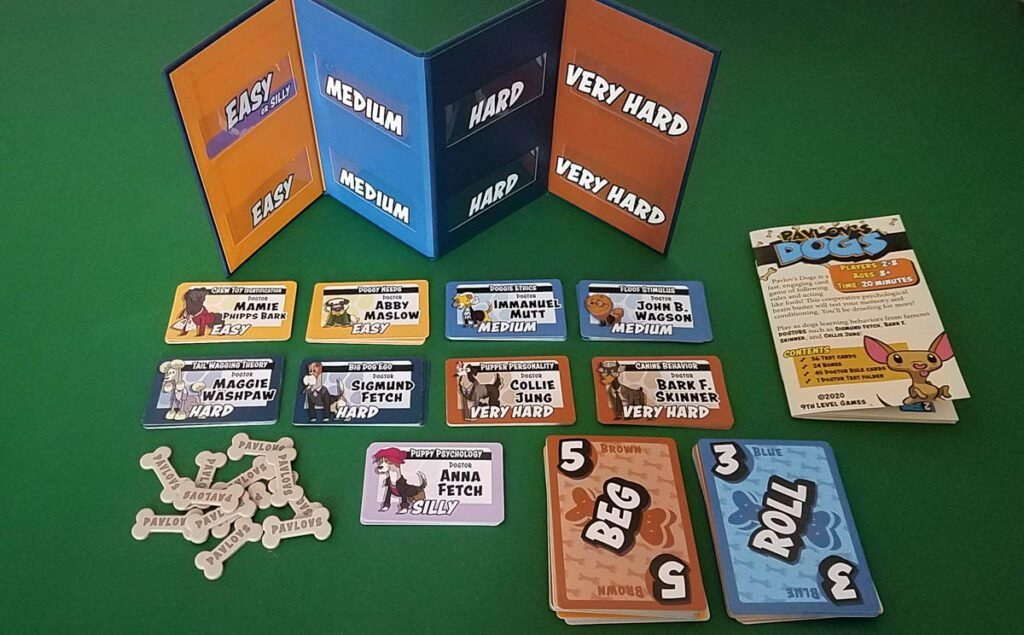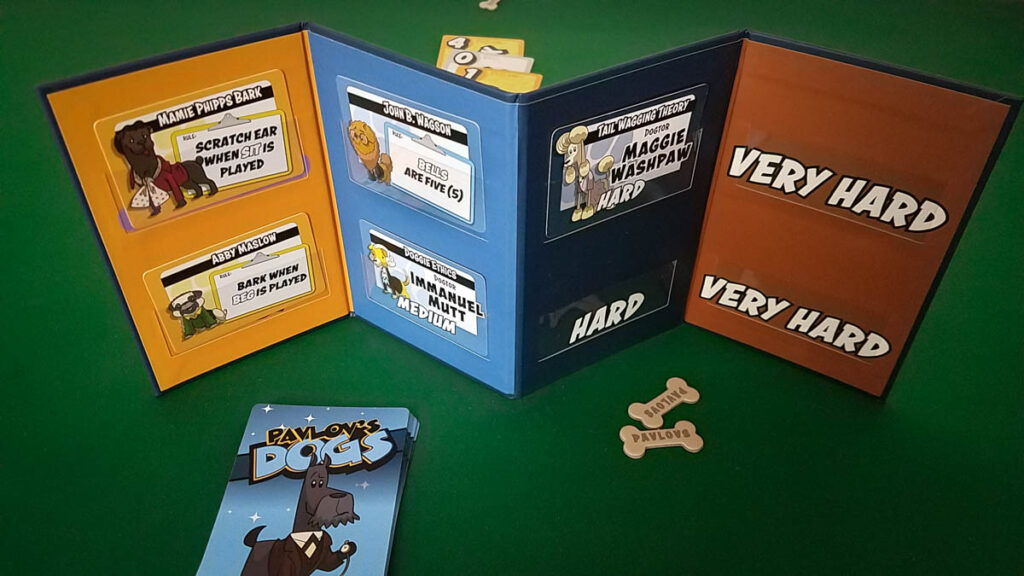Pavlov’s Dogs Review
Year: 2020 | Players: 2-8 | Minutes: 20+ | Ages: 8+
This Pavlov’s Dogs review was made after playing the game seven times. We were sent a copy of this game by the publisher in exchange for an honest review.
What is Pavlov’s Dogs?
Pavlov’s Dogs is a cooperative memory game in which you play as dogs who have to add up the values of cards while also remembering the different rules that your Dogtor has given you.
Pavlov’s Dogs was designed by Heather O’Neill (Meeple Party) and it’s published by 9th Level Games.
Rules Overview
In Pavlov’s Dogs, each player gets three bones to start with and your goal is to make it through a number of rounds (based on the difficulty level you chose) without anyone running out of bones. You’ll get a score based on how many bones your team still has at the end of the game.
One player is the “Dogtor” each round while the other players are the dogs. The dog players all have five Test cards and they take turns revealing cards from their decks until everyone is out of cards. On your turn, you reveal a card, add it to any previously played cards, and then say the total value of those cards.
At the beginning of each round, the current Dogtor reveals one new Rule card and then hides it behind the Test Folder screen. The Rule cards change the rules for the current round and all future rounds. For example, one Rule card has the dog players bark whenever a “Speak” card is played, so if you played that card and the total of all of the cards on the table was 12, you’d have to make a barking sound before saying “12.”
There are multiple Rule cards that make you say or do something, but there are also some that change the values of cards, some that change the turn order, and others. Each player has to remember the rules and can’t get help from their teammates when they’re stuck.
When a dog player is correct, the Dogtor says “Good dog” and the next player takes a turn. If they’re incorrect, the Dogtor says “Bad dog,” removes a bone from that player, clears any previously played cards, and the next dog player takes their turn.
After you complete a round, you can redistribute bones (you usually do this so everyone has at least two bones), and then a new player becomes the Dogtor and they reveal a new Rule card. The game gets tougher the more rounds you play since you have to remember the new rule and all of the rules from the previous rounds.
There’s also a Team vs. Team variant, which is basically the exact same game except both teams get their own sets of Rule cards and the team with the most bones remaining at the end of four rounds wins.
Pros and Cons
Pros
- Pavlov’s Dogs provides plenty of hilarious moments. Everyone I played this with got a kick out of hearing the Dogtor players saying “good dog” over and over again. What really got me multiple times was when someone would forget a rule and then bark hoping that they would be called a good dog.
- This game is surprisingly challenging, even at the medium difficulty level. We’ve had a pretty easy time getting through the first couple of rounds, but we start struggling once that third rule is introduced.
- Pavlov’s Dogs definitely has a different feel to it. Having to count while also remembering new rules is a unique (and fun) team challenge.
- It also has pretty good replayability. You only use one of the five cards from each Rule deck and you can play with different combinations of Rule decks, so each game plays out a little differently.
- There aren’t a lot of cooperative games for large groups, but I think Pavlov’s Dogs will play well all the way up to eight players. I’ve played it at two, three, and five players, and it just got better with more players. Eight would be extremely challenging since you’d have to get through 36 cards every round, but I still think it’d be a lot of fun.
- I’m always a fan of games that can be played by different types of groups, and that’s certainly the case with Pavlov’s Dogs. Older kids can play it on their own, it works great as a quick co-op game for families, and adult groups can enjoy it as a party game or as a filler game.
- I really like this game’s goofy art style.
Cons
- The card quality is pretty low. A couple cards were marked after only a handful of light shuffles. Nothing major yet, but I could see it becoming a bigger problem after more plays.
- I’m not a fan of the two-player version of this game. You still only give the dog players four cards, so it’s pretty easy and there is a much lower chance of those funny moments I mentioned earlier. I tested it out once and we decided to play something else after three rounds.
Final Thoughts
I’m definitely going to be keeping Pavlov’s Dogs. It’s a very clean design, it’s quick, it’s challenging, and, most importantly, it’s a unique co-op experience. It’s very possible that this game made me laugh more than I ever have while playing a board game, and everyone I played it with was fully engaged throughout (well, other than during that quick two-player game).
If you like lighter co-ops, definitely check out Pavlov’s Dogs. I’d also recommend it to anyone looking for a cooperative game that they can break out with pretty much any crowd because it does work with gamers of all ages and different group sizes. It can even work as a kids co-op game!
I’m officially a fan of Heather O’Neill, who also designed the solid puzzle game Meeple Party. I’m looking forward to checking out her future games.
- Update: Pavlov’s Dogs was added to our Best Party Games list!
Pavlov’s Dogs Links
BGG | Amazon | Noble Knight
Thanks for taking the time to read our Pavlov’s Dogs review!
Be sure to also take a look at our Top Cooperative Board Games list and other rankings.
To stay updated on all things co-op board games and card games, follow us on Facebook and X.



